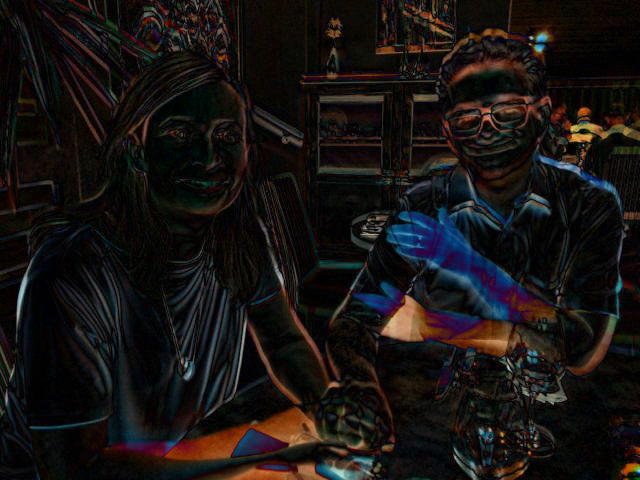Thursday Threads: Man Photocopies Ebook, Google AutoAwesomes Photos, Librarians Called to HTTPS
In this week's threads: a protest -- or maybe just an art project -- by a reader who saves his e-book copy of Orwell's 1984 by photocopying each page from his Kindle, the "AutoAwesome" nature of artificial intelligence, and a call to action for libraries to implement encryption on their websites.
Feel free to send this newsletter to others you think might be interested in the topics. If you are not already subscribed to DLTJ's Thursday Threads, visit the sign-up page. If you would like a more raw and immediate version of these types of stories, follow me on Mastodon where I post the bookmarks I save. Comments and tips, as always, are welcome.
Use Your Photocopier to Backup you E-book

E-book backup is a physical, tangible, human readable copy of an electronically stored novel. The purchased contents of an e-book reader were easily photocopied and clip-bound to create a shelf-stable backup for the benefit of me, the book consumer. I can keep it on my bookshelf without worry of remote recall. A second hardcover backup has been made with the help of an online self-publishing house.
- E-book backup, Jesse England, circa 2012
This project is from around 2012, but it first caught my eye this month. The author -- pointing when "some Amazon Kindle users found their copy of George Orwell's 1984 and Animal Farm had been removed from their Kindles without their prior knowledge or consent" -- decided to photocopy each page of his copy of 1984 as it appeared on a Kindle screen and create a bound paper version. The result is as you see in the image to the right.
Eight days ago, someone took the images from Mr. England's page and uploaded the sequence to imgur. The project again circulated around the 'net. There is a digital preservation joke in here, but I might not be able to find it unless the original creator took the text of 1984 and printed it out as QR Codes so the resulting book could be read back into a computer.
How Awesome is Artificial Intelligence?
The other day I created a Google+ album of photos from our holiday in France. Google’s AutoAwesome algorithms applied some nice Instagram-like filters to some of them, and sent me emails to let me have a look at the results. But there was one AutoAwesome that I found peculiar. It was this one, labeled with the word “Smile!” in the corner, surrounded by little sparkle symbols.
It’s a nice picture, a sweet moment with my wife, taken by my father-in-law, in a Normandy bistro. There’s only one problem with it. This moment never happened.- It’s Official: A.I.s are Now Re-Writing History, Robert Elliott Smith, 7-Oct-2014
Follow the link above to see the pictures -- the two source pictures and the combination that Google's algorithms created. The differences are subtle. I loaded both of the source images into Gimp and performed a difference operation between the two layers. The result is the image below.

Black means the pixel color values were identical, so you can see the changes of hand position clearly. (Other artifacts are I assume differences because of the JPEG compression in the original source pictures.)
This reminds me of the trick of taking multiple pictures of the same shot and using a tool like Photoshop to remove the people. Except in this case it is an algorithm deciding what are the best parts from a multitude of pictures and putting together what its programmers deem to be the "best" combination.
Call to Librarians To Implement HTTPS
Librarians have long understood that to provide access to knowledge it is crucial to protect their patrons' privacy. Books can provide information that is deeply unpopular. As a result, local communities and governments sometimes try to ban the most objectionable ones. Librarians rightly see it as their duty to preserve access to books, especially banned ones. In the US this defense of expression is an integral part of our First Amendment rights.
Access isn't just about having material on the shelves, though. If a book is perceived as "dangerous," patrons may avoid checking it out, for fear that authorities will use their borrowing records against them. This is why librarians have fought long and hard for their patrons' privacy. In recent years, that include Library Connection's fight against the unconstitutional gag authority of National Security Letters and, at many libraries, choosing not to keep checkout records after materials are returned.
However, simply protecting patron records is no longer enough. Library patrons frequently access catalogs and other services over the Internet. We have learned in the last two years that the NSA is unconstitutionally hoovering up and retaining massive amounts of Internet traffic. That means that before a patron even checks out a book, their search for that book in an online catalog may already have been recorded. And the NSA is not the only threat. Other patrons, using off-the-shelf tools, can intercept queries and login data merely by virtue of being on the same network as their target.
Fortunately, there is a solution, and it's getting easier to deploy every day.
- What Every Librarian Needs to Know About HTTPS, by Jacob Hoffman-Andrews, Electronic Frontier Foundation, 6-May-2015
That is the beginning of an article that explains what HTTPS means, why it is important, and how libraries can effectively deploy it. This is something that has come up in the NISO Patron Privacy in Digital Library and Information Systems working group that has been holding virtual meetings this month and will culminate in a two-day in person meeting after the ALA Annual convention in San Francisco next month. As you look at this article, keep an eye out for announcements about the Let's Encrypt initiative to kick-off some time this summer; it will give websites free server encryption certificates and provide a mechanism to keep them up-to-date.